Fantastic. Thank you so much 'Neil.Antin'. Very much appreciated. I have some very interesting further reading to undertake on the links you have so kindly provided me with.@Bonesy Jonesy
If you decide on the DIY path with the Elmasonic, recommend you download this free book and read Chapter XIV Precision Aqueous Cleaning of Vinyl Records-3rd Edition - The Vinyl Press which discusses ultrasonic tanks and goes into detail on the pump/filter system which reflects what @tima addresses on his thread tima's DIY RCM | What's Best Audio and Video Forum. The Best High End Audio Forum on the planet! (whatsbestforum.com) as his final setup. Noting that he and @dminches use an Elamsonic P120 for cleaning and then another Elmasonic (single kHz) for rinse. But understand as a DIY that some assembly is required.
Being in the UK, you would not use a 115VAC pump, but the 12VDC pump is available in the UK - see Table XXIV UCM Pump-Filter System Parts List which lists three different price-point designs. I have worked with people in the UK setting these systems up, so I also know that applicable filters are available. However, if you decide on the DIY Elmasonic recommend you use @tima thread for questions, etc.
Keep in mind with the DIY Elmasonic you have two options for drying - you can let the record air-dry or you dry with your Monks.
As far as Kirmuss, its good when using his process. It has the convenience of a drop-in slot record spinner, but it has no option for a filter. If you do not filter it does not take long before you are 'cleaning' with a dirty bath - that's up to you. His unit has a continuous operating limit of about 25-min after which you have to shut it down to cool. Here is his manual KirmussAudio-V12-User-Manual-Vinyl-Restoration-NOV-2021.pdf. The base ultrasonic tank is pretty sure is an Isonic unit - iSonic Inc. (ultrasonic cleaners, ultrasonic accelerators). Be careful of fancy words and tricky phrases - compare this to Elmasonic - Ultrasonic cleaning - Elma Schmidbauer GmbH (elma-ultrasonic.com) and draw your own conclusions.
Degritter Mark II
- Thread starter tima
- Start date
You are using an out of date browser. It may not display this or other websites correctly.
You should upgrade or use an alternative browser.
You should upgrade or use an alternative browser.
That's great. Thank you 'Tima' for your excellent reply post. Very much appreciated.Thanks for that note, Neil. After watching that offering and the pitch given for it for several years now, I would avoid Kirmuss -- my opinion. Thanks for your synopsis covering options.
BJ, Having gone through this for some time now, from building what turned out to be an inexpensive starter setup, it should be no surprise that I speak for what I consider current state-of-the-art. I will advocate for the Elmasonic P120 tank with 0.2 micron filter with Kuzma rotisserie as the base platform for a record cleaning system that will serve you well for years.
My original goal was to build a system that did not require a seperate rinse step, predicated on the idea of using a top grade absolute rated filter for the wash tank. I built that and it worked very well. Eventually I became convinced that rinsing was critical. Happily that coincided with Elmasonic coming out with their 'S' series of UT tanks which were less expensive versions of the P series with fewer functions. David (@dminches ) and I added those to our systems for rinsing and achieved top-flight results.
Using individual components (as we do with our stereos) yields considerable flexibility and control over time, whereas a single do-it-all machine is convenient, but depends on a single source for service and parts. We each make our choices.
Here is a parts list:
tima's DIY RCM
FWIW, I use Zippo, primarily to remove stickers from sleeves, but it works wonders on paint and other similar substances. It evaporates very quickly, however, so there is no ability to soak. Where does this paint even come from?!www.whatsbestforum.com
Pictures on this page:
tima's DIY RCM
I bought the 3ml Calibrated Eye Dropper pipettes Neil mentions, and 1 pint of Tergitol 15-S-9 from Talasonline.com ($21.75 + ship) The calibrated pipettes graduated in 1,2 and 3 ml are a perfect tool for adding Tergitol to a tank - very nice, thanks for the suggestion Neil. I emptied the tank of...www.whatsbestforum.com
TBH I was tipping towards the Kuzma Kit with a Elmasonic P120 as the complete USCM system as I love and use Kuzma equipment and can see the Elmasonic range of USCMs are also for professional use (incl. high level of cleanliness demanded for in the Lab, Hygiene and medical industries etc.)
'Neil.Antin' has also given a very good compromise to the Kuzma US Kit with the P120 with instead using a 'The Vinyl Source' - 'Vinyl Record Cleaner LP Washer Cleaning Machine' that can spin five LPs per batch (it's also made in the UK) with an Elmasonic P60 (also with an external pump and filter etc.) for much smaller batches to clean (like I have) and is also significantly cheaper than the Kuzma and P60.
I have a Sota from years ago but, to be honest, it is not pleasant to use, it is loud, and it is a hands on kind of operation.
I’m tempted by this one, the Degritter Mark
II, although it is expensive. It seems like I could clean all my records while working during the day, I could just pop one in every fifteen minutes.
Do I just put in fresh distilled water with every record?
Is it that easy? Does it do a good job?
My turntable is in the shop so perhaps now is the time to clean my records. I only have about 800 records.
I’m tempted by this one, the Degritter Mark
II, although it is expensive. It seems like I could clean all my records while working during the day, I could just pop one in every fifteen minutes.
Do I just put in fresh distilled water with every record?
Is it that easy? Does it do a good job?
My turntable is in the shop so perhaps now is the time to clean my records. I only have about 800 records.
Last edited:
@Bonesy Jonesy - I was alerted to the most recent posts in this thread by Neil's "@" call out regarding my use of the Monks plus an older KL.That's great. Thank you 'Tima' for your excellent reply post. Very much appreciated.
TBH I was tipping towards the Kuzma Kit with a Elmasonic P120 as the complete USCM system as I love and use Kuzma equipment and can see the Elmasonic range of USCMs are also for professional use (incl. high level of cleanliness demanded for in the Lab, Hygiene and medical industries etc.)
'Neil.Antin' has also given a very good compromise to the Kuzma US Kit with the P120 with instead using a 'The Vinyl Source' - 'Vinyl Record Cleaner LP Washer Cleaning Machine' that can spin five LPs per batch (it's also made in the UK) with an Elmasonic P60 (also with an external pump and filter etc.) for much smaller batches to clean (like I have) and is also significantly cheaper than the Kuzma and P60.
From my perspective, and this may be subjective, I don't like handling a lot of records at once. I tend to buy older copies (not thrift store stuff) that often need a little attention. I'll pre clean on the Monks, rinse, then the LP goes into the KL. If I had an Elma or equivalent I would probably choose to only run a couple records through it --though I gather the US cleaning time is longer than it is on the KL, and that may be the rub. I tend to batch clean in sessions-- 1/2 dozen to a dozen in a session. While a record is in the KL, another is being cleaned on the Monks.
I guess one question is drying since most of the DIY US set ups do not use forced air drying. My best results have come from taking the record from the KL and giving it one last rinse with pure water/vacuum on the Monks. This requires that you use two mats, so the wet side doesn't further contaminate the dry side when you flip the record to do the other side. I don't do this on every record, but have found that it will remove that last iota of groove grunge that even combo cleaning (manual/vacuum + ultrasonic) can't quite tackle.
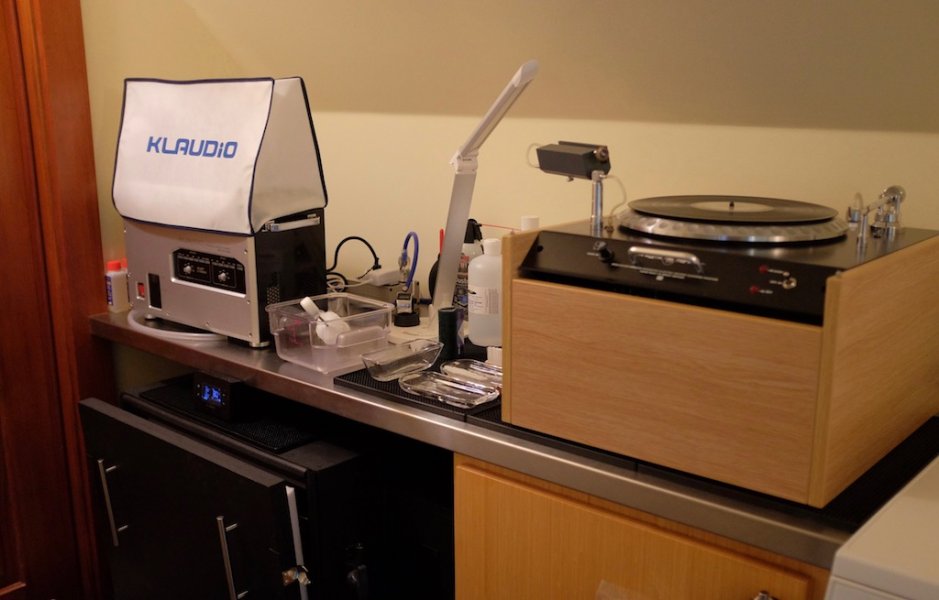
[
Hi Larry,
How often should the water be changed in a Degritter? To some extant that depends on how dirty are the records you are cleaning. The unit does have a small unrated filter. Water change frequency may also partly depend on whether you do a rinse or not. I don't think there is a hard answer. But distilled water is inexpensive in the U.S., so cost to change is small.
Degritter owners, how often do you change tank water? Do you use a seperate rinse cycle?
I have a Sota from years ago but, to be honest, it is not pleasant to use, it is loud, and it is a hands on kind of operation.
I’m tempted by this one, the Degritter Mark
II, although it is expensive. It seems like I could clean all my records while working during the day, I could just pop one in every fifteen minutes.
Do I just put in fresh distilled water with every record?
Is it that easy? Does it do a good job?
My turntable is in the shop so perhaps now is the time to clean my records. I only have about 800 records.
Hi Larry,
How often should the water be changed in a Degritter? To some extant that depends on how dirty are the records you are cleaning. The unit does have a small unrated filter. Water change frequency may also partly depend on whether you do a rinse or not. I don't think there is a hard answer. But distilled water is inexpensive in the U.S., so cost to change is small.
Degritter owners, how often do you change tank water? Do you use a seperate rinse cycle?
Tim:
Here is the manual - The Vinyl Maid Mk II instruction (thevinylsource.co.uk). The record stack attaches to the motor drive by a magnetic coupling. Simply detach (simply pull apart) the record stack from the motor drive and attach another - they provide two kits.
Is the Vinyl Maid built to the same standards as the Kuzma no, but that is reflected in the price, and both appear to be using a high torque gear-drive motor at similar speeds.
Vinyl Records Cleaner/Washing Machine (thevinylsource.co.uk) - £320.00
KUZMA RD Ultrasonic Record Cleaning kit (mackenziehifi.com) - £1,250.00
Take care,
Neil
Thanks Neil for the further informatio about the Vinyl Maid.
Thinking about using it ... I'm guessing one sits it on its magnetic coupler with the spindle pointing up, then slide the discs and records on appropriately. Ideally it wants to sit on a steady metal surface to which the magnet attaches, otherwise it is too easy to tip over. Something similar for drying, where the records are held at an angle rather than parallel to the base.
Have you heard from people using the VM for some time?
Tim,Have you heard from people using the VM for some time?
I am not familiar with any number of people using the Viny Maid. I noticed it mentioned on a site and investigated. Its concept is similar to the Vinyl Stack Ultra Sonic Spin Kit The Vinyl Stack Ultrasonic Spin Kit - A quick look at ultra-coolness! - YouTube that many people use, but no longer manufactured. As far as how to assemble, it has a flat base, so placing it on a rubber pad should prevent it from slipping or a quick DIY with a base & the magnet motor hub (buy separate) would work even better.
Take care,
Neil
Tim:Degritter owners, how often do you change tank water? Do you use a seperate rinse cycle?
If you read back on my post where I provided the link to the Degritter manual, they updated their software to include the option of using a separate rinse tank, and the manual states "It is recommended to change the water in the tank at least once every 1-2 weeks or after every 30 records. This is to avoid any microbial growth." The comments from people generally indicate they are refreshing the bath generally after 20-25 records or weekly. And, for many people this is good enough. Many people use the Degritter low foaming surfactant for wetting only in what is essentially a no-rinse concentration. Other people go the extra with a separate rinse. Some are using it as a final polish (DIW only) after pre-clean with a vacuum-RCM. The unit is pretty flexible that way. And note that the Degritter manual is excellently written.
Take care
Neil
Hi 'Bill Hart',@Bonesy Jonesy - I was alerted to the most recent posts in this thread by Neil's "@" call out regarding my use of the Monks plus an older KL.
From my perspective, and this may be subjective, I don't like handling a lot of records at once. I tend to buy older copies (not thrift store stuff) that often need a little attention. I'll pre clean on the Monks, rinse, then the LP goes into the KL. If I had an Elma or equivalent I would probably choose to only run a couple records through it --though I gather the US cleaning time is longer than it is on the KL, and that may be the rub. I tend to batch clean in sessions-- 1/2 dozen to a dozen in a session. While a record is in the KL, another is being cleaned on the Monks.
I guess one question is drying since most of the DIY US set ups do not use forced air drying. My best results have come from taking the record from the KL and giving it one last rinse with pure water/vacuum on the Monks. This requires that you use two mats, so the wet side doesn't further contaminate the dry side when you flip the record to do the other side. I don't do this on every record, but have found that it will remove that last iota of groove grunge that even combo cleaning (manual/vacuum + ultrasonic) can't quite tackle.
View attachment 112116
Thank you very much for your very useful information particularly on how you use the KM RCM along with the KL USCM. Very much appreciated.
Regarding the use of just pure water (assume you use pure distilled water ???) for the final rinse and drying on the KM, don't you have any issues with getting the pure water to evenly disperse over the complete record surface ?
I have tried using pure distilled water as a rinse on my KM and the water just doesn't cover the complete record surface leaving some areas dry when vacuuming up the rest of the water !
No, no problems. For years, I've been using Reagent Grade I-- I don't think that makes a difference in surface tension but if my circular reasoning is correct, the justification for the rinse is that there is still probably some residue of cleaning fluid left on the record and that small amount is probably enough to break surface tension and let the water do its thing. I like the Monks brushes for water application; I use the Lloyd Walker Prelude applicators (now no longer available but I have a stash for extra pads for them) to apply AIVS #15. I stop the motor on the Monks when I agitate, just to avoid damage to the machine.Hi 'Bill Hart',
Thank you very much for your very useful information particularly on how you use the KM RCM along with the KL USCM. Very much appreciated.
Regarding the use of just pure water (assume you use pure distilled water ???) for the final rinse and drying on the KM, don't you have any issues with getting the pure water to evenly disperse over the complete record surface ?
I have tried using pure distilled water as a rinse on my KM and the water just doesn't cover the complete record surface leaving some areas dry when vacuuming up the rest of the water !
PS: I'm not shy about applying fluid or water on the Monks but learned to have a towel (I use microfiber cloth) handy to mop up the excess on the deck around the platter, and when done, do a very thorough drying of the Monks using compressed air and microfiber towels. I've seen some old Monks that got rusted water on the surface of the top plate. I also installed silicone washers between any sheet metal screws and the top plate to minimize potential rust.
Thank you 'Bill Hart'. Much appreciated.No, no problems. For years, I've been using Reagent Grade I-- I don't think that makes a difference in surface tension but if my circular reasoning is correct, the justification for the rinse is that there is still probably some residue of cleaning fluid left on the record and that small amount is probably enough to break surface tension and let the water do its thing. I like the Monks brushes for water application; I use the Lloyd Walker Prelude applicators (now no longer available but I have a stash for extra pads for them) to apply AIVS #15. I stop the motor on the Monks when I agitate, just to avoid damage to the machine.
PS: I'm not shy about applying fluid or water on the Monks but learned to have a towel (I use microfiber cloth) handy to mop up the excess on the deck around the platter, and when done, do a very thorough drying of the Monks using compressed air and microfiber towels. I've seen some old Monks that got rusted water on the surface of the top plate. I also installed silicone washers between any sheet metal screws and the top plate to minimize potential rust.
Yes I like the KM brushes too especially the latest ones which have white bristles and are very soft, although they are very expensive for what they are ! I use these brushes for the main cleaning process using the KM 33/45 Discovery cleaning fluid (very expensive now). For a KM pre-wash for dirty records I use the KM 'Break the Mold' Discovery cleaning fluid with my original KM brushes (which have stiffer and beige coloured bristles). I don't use the KM RCM hand pump and brush head applicator anymore for the KM main wash as I found I was using too much cleaning fluid. Instead for both the pre-wash and main wash I use the new softer brushes and the original brushes manually in my hand and apply both the pre-wash and main was KM cleaning fluids from plastic bottles that has a long 'U' bend nozzle made for this task of applying cleaning fluid direct to the record surface (bought them off Analogue Seduction in the UK where I also buy my KM cleaning fluids from). This gives me precise control both for applying the cleaning fluids and applying them with the KM brushes.
Thank you 'Bill Hart'. Much appreciated.
Yes I like the KM brushes too especially the latest ones which have white bristles and are very soft, although they are very expensive for what they are ! I use these brushes for the main cleaning process using the KM 33/45 Discovery cleaning fluid (very expensive now). For a KM pre-wash for dirty records I use the KM 'Break the Mold' Discovery cleaning fluid with my original KM brushes (which have stiffer and beige coloured bristles). I don't use the KM RCM hand pump and brush head applicator anymore for the KM main wash as I found I was using too much cleaning fluid. Instead for both the pre-wash and main wash I use the new softer brushes and the original brushes manually in my hand and apply both the pre-wash and main was KM cleaning fluids from plastic bottles that has a long 'U' bend nozzle made for this task of applying cleaning fluid direct to the record surface (bought them off Analogue Seduction in the UK where I also buy my KM cleaning fluids from). This gives me precise control both for applying the cleaning fluids and applying them with the KM brushes.
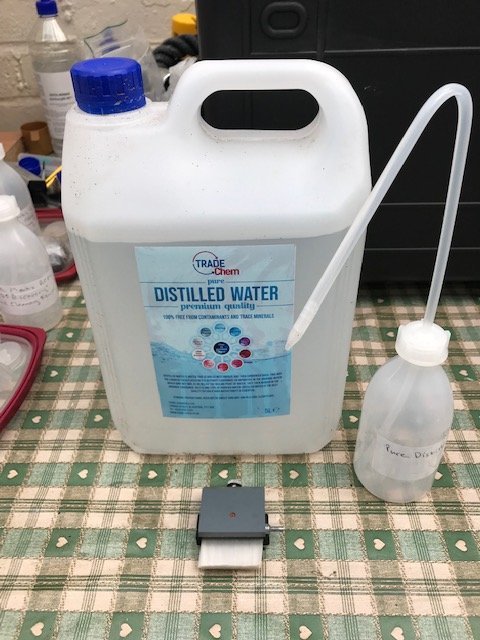
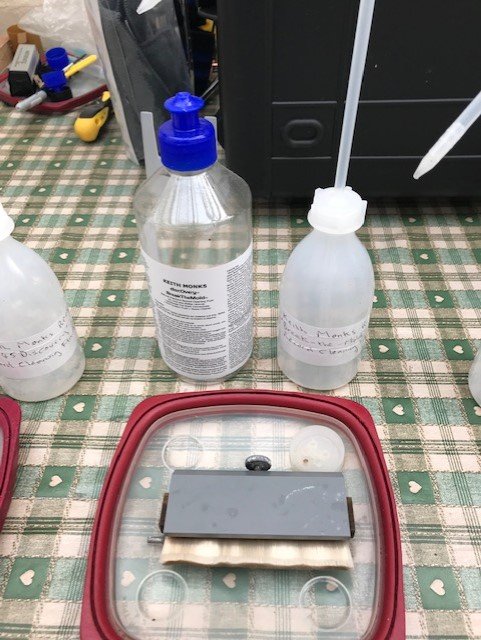
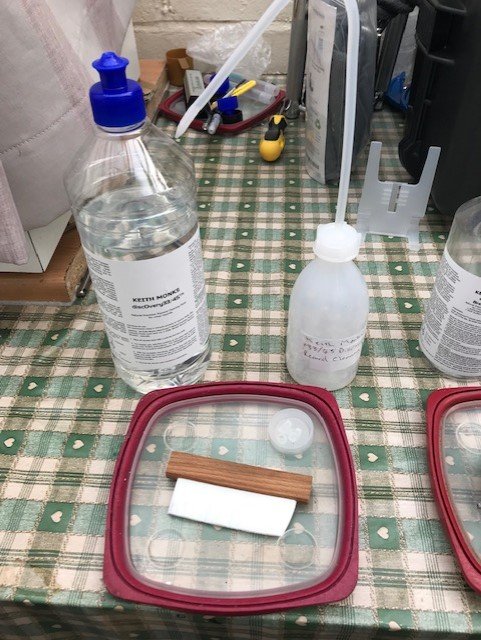
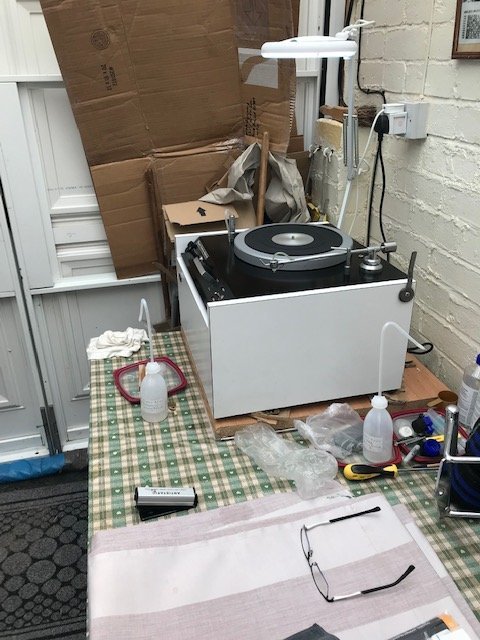
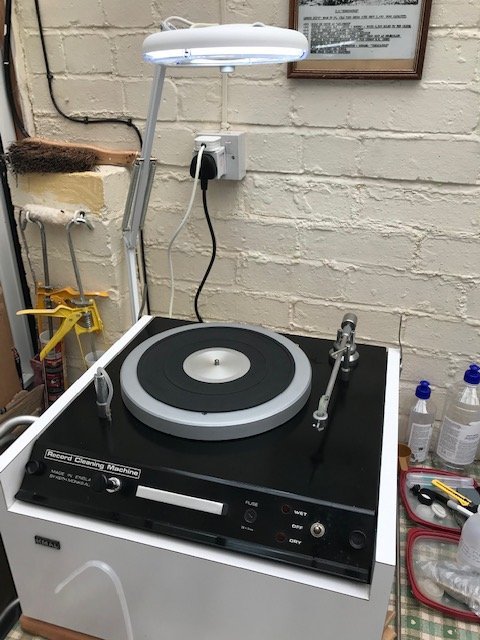
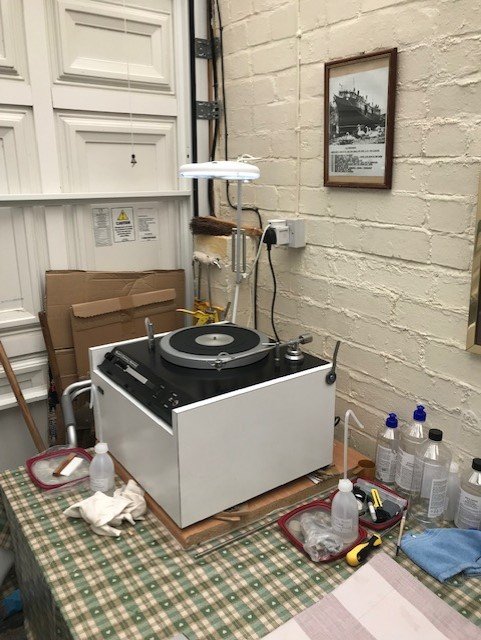
Thanks for finding this out! Changing the bath every 20-25 records is fine. I thought I would have to do it after every record.Tim:
If you read back on my post where I provided the link to the Degritter manual, they updated their software to include the option of using a separate rinse tank, and the manual states "It is recommended to change the water in the tank at least once every 1-2 weeks or after every 30 records. This is to avoid any microbial growth." The comments from people generally indicate they are refreshing the bath generally after 20-25 records or weekly. And, for many people this is good enough. Many people use the Degritter low foaming surfactant for wetting only in what is essentially a no-rinse concentration. Other people go the extra with a separate rinse. Some are using it as a final polish (DIW only) after pre-clean with a vacuum-RCM. The unit is pretty flexible that way. And note that the Degritter manual is excellently written.
Take care
Neil
Roughly how long will it take me to clean 20 records?
Degritter is good for 3k+ cleans and for a modest fee they will rebuild the machine to new if/when it wears out. I think I saw it mentioned that one machine was over 5k cycles.
I jinxed myself. My older Degritter (2019) has died after about 1800 cycles. Pump stopped working. Even though I’m out of warranty Degritter offered a fair discount to bring my unit up to the current Mk.1 spec. They use my shell but all the guts are new. Great service but a little disappointed in the premature death, granted mine was I believe a less robust earlier version.
- New record revolving motor and belt drive
- New display with better colours
- New pumps
- Bottom most water level sensors will be replaced with a service-free solution
- Slightly improved ultrasonic amplifier
- Run cycle counter will be reset to 0
- + 1 year warranty.
It all depends on what cleaning cycle you choose and drying time. Go to this link Update your record cleaner software | Degritter, scroll down and download and read the operators manual - it's very well written. Note that the 20-records is not hard & fast, it depends on how dirty the records are you cleaning; you are kind of winging it; eyeballing the bath. Otherwise, over at SH there is a long-standing and active thread: Degritter Users | Page 146 | Steve Hoffman Music ForumsThanks for finding this out! Changing the bath every 20-25 records is fine. I thought I would have to do it after every record.
Roughly how long will it take me to clean 20 records?
Hi 'Bill Hart',@Bonesy Jonesy - I was alerted to the most recent posts in this thread by Neil's "@" call out regarding my use of the Monks plus an older KL.
From my perspective, and this may be subjective, I don't like handling a lot of records at once. I tend to buy older copies (not thrift store stuff) that often need a little attention. I'll pre clean on the Monks, rinse, then the LP goes into the KL. If I had an Elma or equivalent I would probably choose to only run a couple records through it --though I gather the US cleaning time is longer than it is on the KL, and that may be the rub. I tend to batch clean in sessions-- 1/2 dozen to a dozen in a session. While a record is in the KL, another is being cleaned on the Monks.
I guess one question is drying since most of the DIY US set ups do not use forced air drying. My best results have come from taking the record from the KL and giving it one last rinse with pure water/vacuum on the Monks. This requires that you use two mats, so the wet side doesn't further contaminate the dry side when you flip the record to do the other side. I don't do this on every record, but have found that it will remove that last iota of groove grunge that even combo cleaning (manual/vacuum + ultrasonic) can't quite tackle.
View attachment 112116
Nice RCM set-up you have there
If you had to buy a new USCM and you haven't got one yet (like in my situation) or even that you needed to replace your current KLAudio USCM, would you buy the new KLAudio 'KD-CLN-LP200T' USCM and if you wanted to clean more than one record at a time, to go with the LP200T buy a KLAudio 'KD-ATL-RCM05' that can auto clean and dry 5 LPs at a time. Or would you buy say the Elma Elmasonic P60H USCM with a 'The Vinyl Source' - 'The Vinyl Maid MK 11b' 5 LP loader and spinner to clean 5 LPs at the same time ?
Cost is one advantage on the Elmasonic P60H with 'The Vinyl Maid MK 11b' over the KLAudio LP-200T with the RCM05 as the KLAudio is approx. +6.5 x the cost of the Elma and Vinyl Maid MK 11b !
Putting cost to one side, and looking at maintenance, longevity, servicing etc. I would say they are most probably pretty much equal, although I would think the KLAudio products would be more costly in parts and consumables etc. ?
But what about the performance in cleaning records ? Any idea which would be the best performer between these two set-ups ?
Also the KLAudio LP200T USCM can operate with only tap water or bottled drinking water (according to it's manual) i.e. no chemicals etc. needed to be added. Whereas the Elmasonic USCM will need chemicals added plus you will be using distilled water as well which adds to the cost of consumables etc. ?
For sure I will still use my Keith Monks (KM) Classic RCM as a pre-wash before using a USCM and also most probably use the KM for a final rinse wash with distilled water like you have suggested Bill.
Your thoughts based on your experiences Bill would be greatly appreciated.
p.s. For your KM RCM, do you use the KM 'Discovery' and 'Break the Mold' cleaning fluids or do you use an alternative or go DIY route and make up your own cocktail ?
@Bonesy Jonesy-
On Next US RCM- I'm not sure. I was kicking around the idea of an industrial grade machine. @Neil.Antin had at one point brought up the machines made by Zenith, which are typically factory line type for industry. They make a bench top. I had talked to the owner many years ago about making me a custom machine, and he wasn't interested but they do make a bench top. As Neil has pointed out, it may be overkill for my needs, take up a lot of space and then there's the cascading bath if I use a surfactant.
I think the new KL with the remote tank is pricey for what it is, I'm not sure about the calibre of the filtering and the fact that it has to use tap water to trigger the sensors gives me some qualms.
The DeGritter seems to be a popular favorite, my friend @Albert Porter swears by his and he's had 'em all. Short answer, I don't know.
On fluids- I found the Monks gummy and was concerned that it might actually be masking noise- not a bad thing in some cases, but not what I want. Even Art Dudley (RIP) commented on the sticky residue it left on his brush.
I use a fluid concentrate from the old Hannl company out of Germany which is no longer available for a light wash, and AIVS #15 for deeper cleaning. I always rinse.
One downside of using surfactants-- which the Zenith guy first convinced me significantly enhanced US cleaning effectiveness, is removing them. That's why I don't like forced air drying with a US that uses a surfactant.
The combo of the Monks and the KL are synergistic. What I'll replace the KL with is still open, if and when. As to the Monks, it will go on the Viking ship funeral pyre with me when they set it afire and launch me to sea, wearing horned helmet, playing Steppenwolf at 105db.
On Next US RCM- I'm not sure. I was kicking around the idea of an industrial grade machine. @Neil.Antin had at one point brought up the machines made by Zenith, which are typically factory line type for industry. They make a bench top. I had talked to the owner many years ago about making me a custom machine, and he wasn't interested but they do make a bench top. As Neil has pointed out, it may be overkill for my needs, take up a lot of space and then there's the cascading bath if I use a surfactant.
I think the new KL with the remote tank is pricey for what it is, I'm not sure about the calibre of the filtering and the fact that it has to use tap water to trigger the sensors gives me some qualms.
The DeGritter seems to be a popular favorite, my friend @Albert Porter swears by his and he's had 'em all. Short answer, I don't know.
On fluids- I found the Monks gummy and was concerned that it might actually be masking noise- not a bad thing in some cases, but not what I want. Even Art Dudley (RIP) commented on the sticky residue it left on his brush.
I use a fluid concentrate from the old Hannl company out of Germany which is no longer available for a light wash, and AIVS #15 for deeper cleaning. I always rinse.
One downside of using surfactants-- which the Zenith guy first convinced me significantly enhanced US cleaning effectiveness, is removing them. That's why I don't like forced air drying with a US that uses a surfactant.
The combo of the Monks and the KL are synergistic. What I'll replace the KL with is still open, if and when. As to the Monks, it will go on the Viking ship funeral pyre with me when they set it afire and launch me to sea, wearing horned helmet, playing Steppenwolf at 105db.
Thank you Bill for your very informative and very speedy response. Very much appreciated.@Bonesy Jonesy-
On Next US RCM- I'm not sure. I was kicking around the idea of an industrial grade machine. @Neil.Antin had at one point brought up the machines made by Zenith, which are typically factory line type for industry. They make a bench top. I had talked to the owner many years ago about making me a custom machine, and he wasn't interested but they do make a bench top. As Neil has pointed out, it may be overkill for my needs, take up a lot of space and then there's the cascading bath if I use a surfactant.
I think the new KL with the remote tank is pricey for what it is, I'm not sure about the calibre of the filtering and the fact that it has to use tap water to trigger the sensors gives me some qualms.
The DeGritter seems to be a popular favorite, my friend @Albert Porter swears by his and he's had 'em all. Short answer, I don't know.
On fluids- I found the Monks gummy and was concerned that it might actually be masking noise- not a bad thing in some cases, but not what I want. Even Art Dudley (RIP) commented on the sticky residue it left on his brush.
I use a fluid concentrate from the old Hannl company out of Germany which is no longer available for a light wash, and AIVS #15 for deeper cleaning. I always rinse.
One downside of using surfactants-- which the Zenith guy first convinced me significantly enhanced US cleaning effectiveness, is removing them. That's why I don't like forced air drying with a US that uses a surfactant.
The combo of the Monks and the KL are synergistic. What I'll replace the KL with is still open, if and when. As to the Monks, it will go on the Viking ship funeral pyre with me when they set it afire and launch me to sea, wearing horned helmet, playing Steppenwolf at 105db.
I have looked at the Degritter. Looks a nice compact and quite simple machine. However, it can only do one record at a time and no products available to increase to multiple LPs if the time came to require this !
The KM 'Break the Mold' cleaning fluid is def quite 'gummy' or 'tacky' / sticky and more viscous than the KM 'Discovery' cleaning fluid. However, I only use the 'Break the Mould' for very dirty records before using the 'Discovery'. Never felt the 'Discovery' cleaning fluid to be 'gummy' or 'tacky' / sticky' quite the opposite as it feels quite a thin fluid.
Lol, yes I think my KM RCM will be going with me to my death bed too lol !
You have misinterpreted some items:Also the KLAudio LP200T USCM can operate with only tap water or bottled drinking water (according to it's manual) i.e. no chemicals etc. needed to be added. Whereas the Elmasonic USCM will need chemicals added plus you will be using distilled water as well which adds to the cost of consumables etc. ?
The KLAudio cannot use chemicals - it will make the unit malfunction and could probably damage it. The latest version of the KLAudio appears not to be able to use distilled water because of the water level sensors. So, the inability to use chemistry and distilled water are not benefits - they are limitations. Edit: Bottled drinking water example - water-analysis-report-2019.pdf (dasani.com) generally has about 25-50-ppm total dissolved solids (TDS), while distilled water essentially has <1-ppm.
The Elamsonic does not need to use chemicals - but ultrasonic cleaning efficiency can be improved with chemicals - if you need it. The Elmasonic is consistent with good industry practice being pretty much immune to what you 'can' use absent anything that is flammable.
For record cleaning, no ultrasonic tank should use tap water (regardless of what anyone says) - it will shorten the life of the unit (think about the water spots from your tap water) and as the record spins out of the water, some water can dry on the record, and now you just contaminated the record hoping the return trip to tank will remove it.
Take care,
Neil
Last edited:
Hi Neil,You have misinterpreted some items:
The KLAudio cannot use chemicals - it will make the unit malfunction and could probably damage it. The latest version of the KLAudio appears not to be able to use distilled water because of the water level sensors. So, the inability to use chemistry and distilled water are not benefits - they are limitations. Edit: Bottled drinking water example - water-analysis-report-2019.pdf (dasani.com) generally has about 25-50-ppm total dissolved solids (TDS), while distilled water essentially has <1-ppm.
The Elamsonic does not need to use chemicals - but ultrasonic cleaning efficiency can be improved with chemicals - if you need it. The Elmasonic is consistent with good industry practice being pretty much immune to what you 'can' use absent anything that is flammable.
For record cleaning, no ultrasonic tank should use tap water (regardless of what anyone says) - it will shorten the life of the unit (think about the water spots from your tap water) and as the record spins out of the water, some water can dry on the record, and now you just contaminated the record hoping the return trip to tank will remove it.
Take care,
Neil
Thank you for your very informative reply posting to my posting. Very much appreciated.
It seems that from your information in various reply postings to my postings and your excellent online book (which I have now read) and information from other WBF members regarding this subject on DIY ultrasonic record cleaning (in particular 'tima') that the overall conclusion I have interpreted from reading this information is for my first US RCM with quite low batches of LP cleaning at any given time (i.e. normally 1 or two increasing to possibly 5 LPs to be cleaned in a batch per day), it looks like I will buy in the UK the 'Elma Elmasonic P60H' US CM with 'The Vinyl Source' - 'The Vinyl Maid MK 11b' 5 LP loader and spinner, unless you have a another recommendation ? .
With me living 90% of my time in the UK at the moment, what would you recommend Neil for the type of water and the surfactants I should use and any other chemicals I should add to the P60H US CM (or similar US CM from an alternative you may recommend) ?
Also with only cleaning max 5 LPs in any one batch in a day, would I still need to buy and use an external filter and circulating pump and water cooling radiator etc. for the P60H (or similar US CM from an alternative you may recommend) ?
Similar threads
- Replies
- 9
- Views
- 5K
- Replies
- 322
- Views
- 63K
- Replies
- 3
- Views
- 1K
- Replies
- 56
- Views
- 25K
- Replies
- 1
- Views
- 854
| Steve Williams Site Founder | Site Owner | Administrator | Ron Resnick Site Owner | Administrator | Julian (The Fixer) Website Build | Marketing Managersing |







